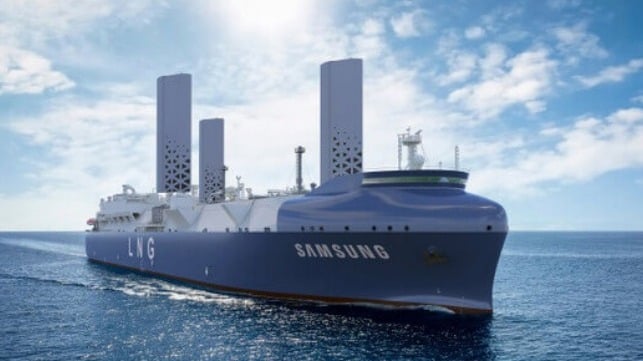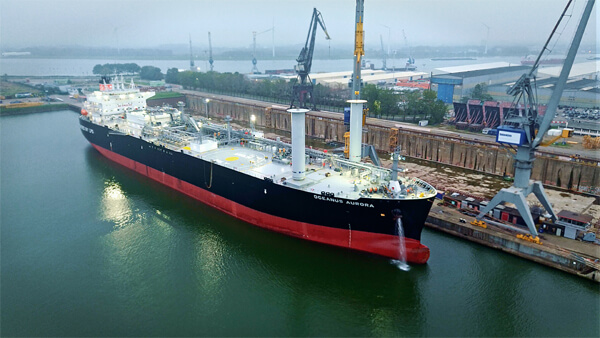Norsepower Installs Rotors on Gas Carrier as SHI Presents New Wind Concept

As wind-assisted propulsion continues to gain momentum it is expanding to more segments of shipping including gas carriers. In the latest examples, Norsepower, which produces rotors completed the installation on a gas carrier while Samsung Heavy Industries received design approval for a new concept that it plans to incorporate into future LNG carriers.
Each class of ship comes with challenges for wind-assisted propulsion ranging from air draft to stability and visibility. General cargo ships, bulkers, and tankers have been among the first to incorporate the technologies while designs to place the different systems on gas carriers emerged this year.
Norsepower reports at the beginning of November the installation of two of its rotor sails was completed on the Oceanus Aurora, a 58,551 dwt Very Large Gas Carrier (VLGC). The vessel which is 755 feet (230 meters) in length is owned by Japan’s IINO Kaiun Kaisha (IINO LINES) and is operating on charter to Borealis. The vessel is reigstered in Liberia.
The ship was delivered in March 2023 from Daewoo Shipbuilding & Marine Engineering Co. (Hanwha Ocean), ready for wind propulsion. The shipyard incorporated the foundations for the Norsepower Rotor Sails into the construction and the installation was completed this month in Rotterdam.
The VLGC Oceanus Aurora was outfitted with two custom-designed units, measuring 20 meters (approximately 66 feet) tall and 4 meters (13 feet) in diameter, tailored to meet the vessel’s precise air draught limits. The units use a small amount of electrical power to turn the rotors and create the propulsive force. Norsepower calculates that the Oceanus Aurora which sails between Houston and Stenungsund, Sweden, or Porvoo, Finland, will reduce fuel consumption and CO2 emissions by approximately four percent.
Norsepower which was started 12 years ago reports so far 28 Rotor Sails have been installed onboard 15 vessels. Installation orders within the next 18 months consist of 34 units on a further 13 ships.

Rotors installed on the gas carrier which was built in 2023 ready for wind-assisted propulsion (Norsepower)
Samsung Heavy Industries reports it is further advancing the concepts of wind-assisted propulsion having received initial design approval for a LNG carrier using wing sails. The sail-shaped structure designed by SHI functions by utilizing the principle of lift generated by the pressure difference between the upper and lower parts of the wing, It would be further enhanced by an air reduction device SHI is calling SAVER Air. The company said that the combination of the wing sail and SAVER Air can significantly improve fuel efficiency while simultaneously reducing carbon emissions.
The yard is presenting its design incorporated into a futurist LNG carrier. To address the issues of visibility, SHI proposes placing the bridge at the front of the vessel. The design also incorporates further aerodynamics to improve efficiency.
The Korean Register of Shipping and the Liberian Registry have both issued Approval in Principle (AiP) for the design concepts. Samsung Heavy Industries reports it will proceed to commercialization for its wing sail while also working to expand it into the design of other future vessels including ammonia or CO2 carriers.
Other companies, including Mitsui O.S.K., Chevron Shipping, and Oshima Shipbuilding, which is partnered with MOL on a rigid sail, have announced plans to incorporate wind-assisted propulsion into the gas carrier segment. Hanwha Ocean is contracted to build an LNG carrier for MOL due for delivery in 2026 incorporating the rigid sail. Samsung Heavy Industries cites data from the UK Department of Transport's Clean Maritime Plan highlighting that the market for wind-assisted propulsion technology could grow to nearly $2.5 billion by 2050.
